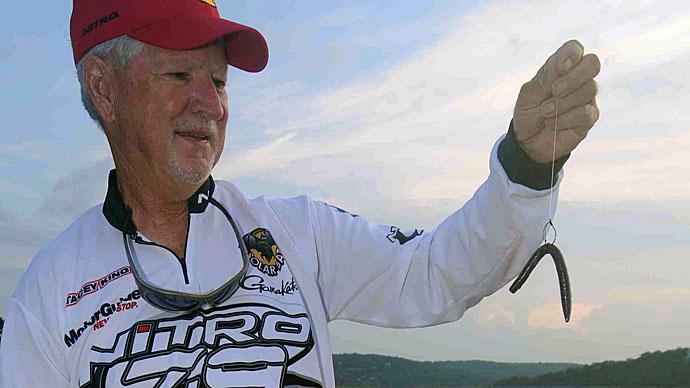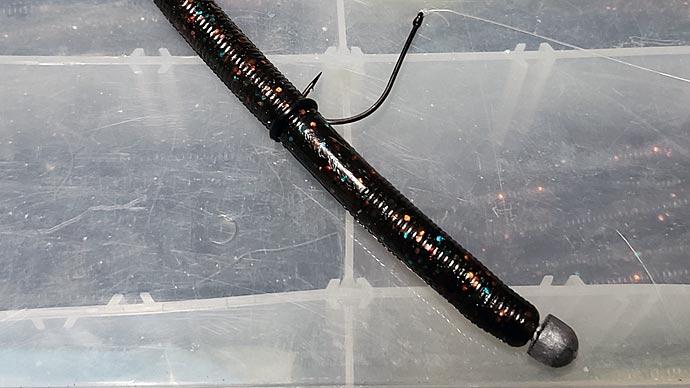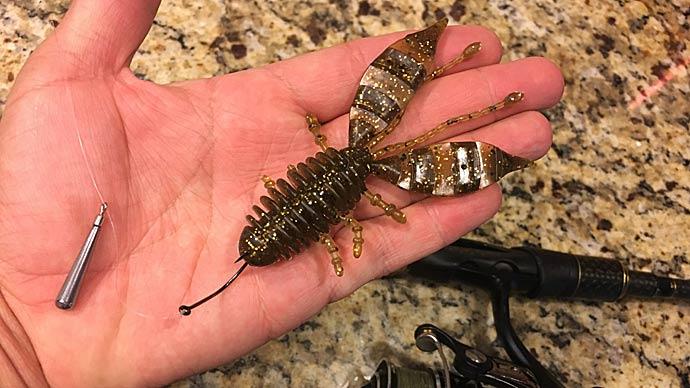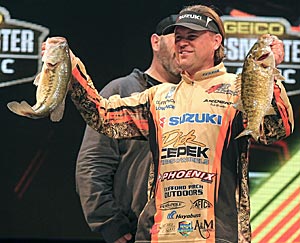
Wacky rigged soft-plastic lures are bass-catching machines. Their slow fall and wiggles are irresistible to fish. But they require patience on the part of the angler. Without a weight, it takes time for them to reach the bottom or at least the depth where bass are suspended. Adding weight solves that problem. Wacky jig rigged worms, such as Jackall’s Flick Shake, preserve the action and bring a faster sink and better cover penetration.
Wacky rigged soft-plastic lures take on a different action when the weight is moved from the middle. Enter the Neko rig, whose hook is inserted mid-lure with the point exposed, as it is in wacky rigs, but the weight is inserted into one end.
While Neko rigs also offer the same fall and action that make wacky-rigs such great bass catchers, they bring something unique to the table. While one end of the soft-plastic lure floats off the bottom, the other is pinned to the bottom. That helps you create pinpoint presentations. A Neko rig stays put where a current, wind-blown slack line or waves take weightless wacky-rigs random places.
Payson, Ariz. Bassmaster Elite Series angler Cliff Pirch knows finesse fishing. He learned it fishing on the deep, clear, and often pressured fisheries of the western U.S. The Neko rig is one of his favorite finesse presentations. Here’s how he rigs his to catch more bass.
Limit your lure choices
Pirch chose a small selection of soft-plastic lures when assembling his Neko rig. His most-used options are Big Bite finesse worms or stick worms. “I don’t get tricky with it,” he said. Both have a natural profile and enough action to solicit strikes. He also keeps the colors simple, matching the conditions, such as a dark worm in dark water or choosing one that historically has worked in the region where he’s fishing.
But worms aren’t the only soft-plastic lures you can fish on a Neko rig. A craw worm also would work, Pirch said, especially when irritating a bedded bass into striking.
The key to any wacky-rigged finesse presentation is using a soft-plastic lure that works for you. Even at rest, it must wiggle because the less you move a wacky rig, the more bass it catches.
Fish it on the correct rod
Pirch always picks a spinning outfit for fishing Neko rigs. The rod is 7 feet long and has a medium action, flexing about halfway through the blank. That requires effort to load, helping cast light rigs and hook soft bites.
Match your rod to a quality spinning reel with a smooth drag and large-diameter spool. The drag will keep more bass hooked, especially when using smaller hooks, and the line wraps around the spool in bigger coils, reducing the tangles that most often come when tightly wound around smaller spools.
Strengthen it with two lines
Pirch loads his spinning reel with braided line, choosing as light a weight as cover permits. Its lack of stretch provides plenty of sensitivity, allowing him to feel the slightest bite. It also helps him work his Neko rig. “You don’t have a lot of weight, so you want to be able to see the line move,” Pirch said. “If it moves 1 inch at the bait, it’s an inch at your rod tip.”
Pirch doesn’t tie his braid directly to his Neko rig’s hook. Instead, he adds a 7-feet to 8-feet long fluorocarbon leader in between. That length allows him to retie his hook several times without replacing the entire leader. It also keeps his knot out of the spool, where it can be damaged and cut casting distance.
There are two more reasons why you should use the braid-fluorocarbon combination. The first is sensitivity. Fluorocarbon’s minuscule amount of stretch is unnoticeable next to braid, especially when compared to springy monofilament. That keeps you tight to what’s happening with your Neko rig. Pirch said the second is that fluorocarbon sinks, unlike monofilament, dragging lightly weighted Neko rigs deeper and keeping them there.

Pirch connects the two lines with a Crazy Alberto knot, which shines when connecting lines of different diameters. It starts with doubling over the thicker leader. Then the braid is run through the loop created and wrapped 14 times — seven down and seven back — around both pieces of leader. Finally, the tag is run back through the loop in the same direction as the first time. He believes it’s faster and easier to tie than an FG knot and stronger than the double-uni knot, another popular means of connecting two lines.
Stick with the correct hook
Tackle shops carry plenty of wacky rigging hooks, Pirch said, because more bass anglers are fishing the presentation more often. But don’t get lost in the choices. When selecting the best Neko rig hook, you only need to remember a few things.
It’s tough to beat a straight-shank hook when rigging soft-plastic lures. Pirch said its length improves your hook-up ratio because of the larger gap between the point and line tie. Roboworm’s ReBarb hook is one he chooses when he wants a long-shank hook.
When Pirch needs a compact hook because of thick cover, such as brush or aquatic vegetation, he ties on Hayabusa’s Special Wacky Wire Guard hook. As its name implies, this hook sports a fine-wire weed guard. Its shorter shank, like those associated with most hooks marketed for wacky rigging, reduces its gap, making it more weedless than a long-shank hook. The size of either style should be chosen based on the lure you’re rigging. For example, a thick 4-inch stick worm will need a larger hook than a tiny 4-inch finesse worm.
Add just enough weight
The piece that makes Neko rigs work is the weight. They come in a variety of sizes and shapes. All have at least one portion shaped like a nail sporting tiny barbs or ridges. It keeps the weight stuck in the plastic, though it never hurts to add a drop or two of superglue for added grip.
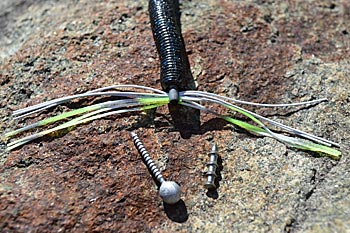
Neko weights are made of lead or tungsten. Some have a ball on one end, and VMC, for example, makes one sporting a skirt. There’s even one that twists into your worm with a spring. Pirch looks beyond those, choosing a Big Bite nail weight between 1/32 and 1/8 ounce. “That usually covers the range [of depths],” he said.
Even though it’s a finesse presentation, there are benefits to putting a relatively heavyweight in your Neko rig. “If I can get away with a heavier [weight], it will save me time,” Pirch said. “But if you feel like you have to go light, it just takes more time [to sink]. But if that’s what it takes to get bit, you must do it.”
You’ll want to protect your weight investment. While simply impaling your hook through the soft-plastic lure will create a Neko rig, it won’t be durable. Within a finite number of casts, especially if you catch a bass or two, your lure will rip, parting ways with your hook during a cast or bass jump and taking your weight with it. Reduce that chance by using a small rubber O-ring. Often sold with a small tool for working them onto your soft-plastic lure, place it where you will insert your hook. And instead of putting your hook through the plastic, hook it under the stronger O-ring.
Pick your places
Where you fish is as important as what you are fishing. And in the case of the Neko, there are many places where it’ll catch a bass — largemouth, spotted, or smallmouth. “It’s a real versatile bait as far as depth range,” Pirch said. “I see applications in multiple seasons — early ledge fishing, late winter deep spotted bass, spring spawning in shallows, deep suspended bait in the fall. There are many times when it can be a tool that is applicable.”
Anytime bass are around shallow cover and structure, but conditions or fishing pressure make them tentative, a Neko rig plays. Pirch proved that at Texas’ busy Lake Travis, where he used a Neko Rig, in part, to post a 12th-place finish, sight fishing bass on spawning beds. And if the shallow cover is thick, try using a weedless Neko rig variation — the Chicken rig. Its long-shank hook is Texas rigged with the line tie pointed away from the weight.
But don’t limit yourself to skinny water. “I can fish deep spotted bass with [a Neko rig], 40- to 50-feet deep,” Pirch said. “They like the shape. They like the natural fall, and it’s a light-line technique where you can get it down there.”
Pirch said a couple of adjustments are required to fish deep water. The first is spending more time watching your electronics, whether bass are suspended or locked on the bottom. They’ll help you find them and keep your rig where it can bite.
You’ll need to add weight to your Neko rig, too. It’ll make your fishing more efficient because you’ll spend less time waiting for your offering to reach the bass. And it’ll be easier to keep it there, especially when the wind blows and the waves roll.
BassResource may receive a portion of revenues if you make a purchase using a link above.


